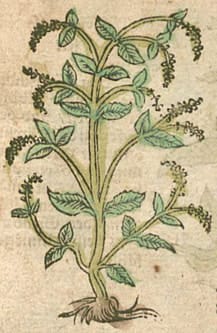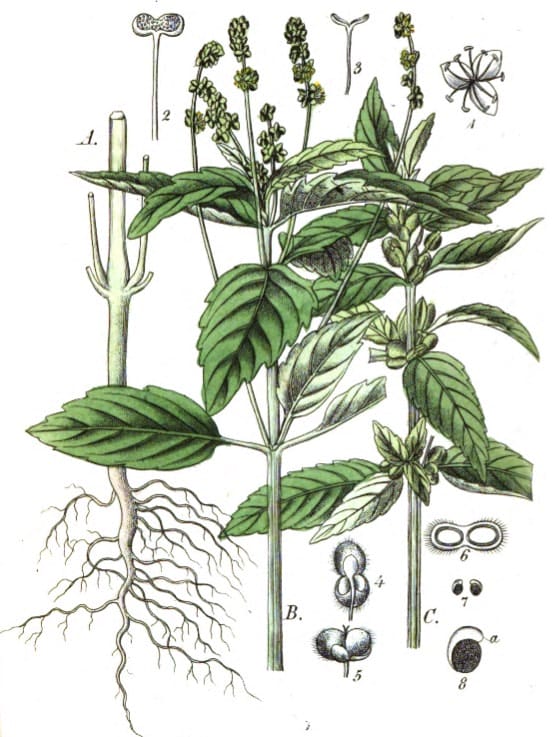Mercurialis, Mercury
Annual, Garden, or French Mercury Kurtzes Handtbuchlein, Ryff, 1599
Kurtzes Handtbuchlein, Ryff, 1599 Flora von Deutschland (2), Kohler, 1842
Flora von Deutschland (2), Kohler, 1842Botanical name:
Mercurialis annua, M. perennis
A number of different Mercury species have been used.
The Chinese have used M. leiocarpa (Tou Ku Cao) but it is not commonly used.
Parts used:
Herb in flower. Some (such as Leclerc) said the dried herb was ineffective.
Temperature & Taste:
Warm, dry. Pungent. Slightly Toxic.
Classifications:
2E LENITIVE 2J. RAREFYING
Uses:
1. Opens Obstructions, Moves the Bowels:
-loosens the Belly, purges Choler and Water (int. and in Enemas)
-Dysuria, Edema, Ascites
2. Clears Damp-Heat, Promotes Urine:
-Arthritis and Rheumatism (Chinese species has been used for Rheumatism, Chinese Materia Medica, Stuart)
-Gonorrhea, Syphilis
3. Moves the Blood, Clears Stasis, Resolves Masses:
-Amenorrhea, Dysmenorrhea
-promotes Birth and cleanses Afterbirth (Lonicerus)
-Tumors, Hard Swellings, Fibroids and Cancer
4. Externally:
-much used for Wounds
-soften and resolve Tumors; Buboes; Warts (cataplasm of fresh leaf)
-suppurating inflammations
-juice mixed with vinegar is applied to Eczema, Ringworm, Pruritus etc.
-externally, applied to the Vagina to draw the Menstruation and Afterbirth
-sore and red eyes
-Burns
Dose:
Decoction: 3–9 grams
Standard Decoction (1 in 8): 200–250 mls.
Juice: 3–5 oz. was traditionally given.
Comment:
1. ‘Male’ and ‘Female’ Mercury herbs were differentiated. It was said that the Male Mercury would produce male children while the Female Mercury would produce female children. Dioscorides said the herb (‘Male’ if a male child is desired, ‘Female’ for a female child) should be taken as drink as well as beaten and applied to the genitals after menstruation. This belief continued into the 16th century (A Niewe Herball, Dodoens, 1578).
2. One of the 5 Emollient Herbs, along with Mallow, Marshmallow, Beet, Mercury, Violet
Main Combinations:
1. A tonic to keep strong and healthy; Mercury juice, Borage juice, Florentine Orris root, Gentian root; prepare a syrup with wine and honey. (as in Madame Fouquet du Laureus’ Life or Wonder Syrup, Deschauer)
2. Strangury, Decoction of Mercury with Myrrh, Pepper
3. Syphilis and Gonorrhea, Mercury with Dandelion root, Heartsease, Burdock root, Fumitory, Fern root, Boldo leaf, Sandalwood, Guaiacum (Finsterwalder)
4. Infertility, herb decocted in wine and water and used as a cataplasm to the pubic area (Herbarium Horstianum, 1630)
5. Enema for Colic, Stones and Hypochondriac Melancholy, Mercury herb, Marshmallow, Agrimony, Betony, Pennyroyal, Oregano, Bay Berry, Camomile, decocted, strained, and oil added (Herbarium Horstianum, 1630)
6. Enema for Stones, Mercury with Parsley and Marshmallow (Herbarium Horstianum, 1630)
7. Sore and red eyes, Mercury distilled water with sugar candy dissolved in it.
Cautions:
1. Toxic in overdose (especially the fresh plant). PDR says all cases of poisoning involve animals and no human poisonings have been reported.
2. Can cause Diarrhea and an overactive Bladder. (Duke)
Main Preparations used:
Distilled Water, Syrup of the Juice, Honey of Mercury
